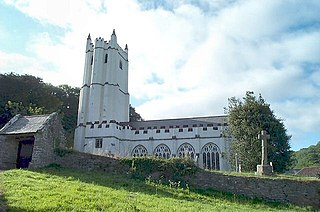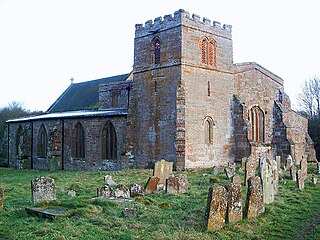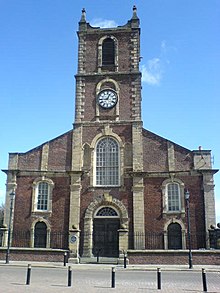
Friends of Friendless Churches (FoFC) is a registered charity formed in 1957, active in England and Wales, which campaigns for and rescues redundant historic places of worship threatened by demolition, decay, or inappropriate conversion. As of April 2021, the charity owns 58 redundant churches or chapels, 29 of which are in England, and 29 in Wales.
The Ancient Monuments Society (AMS) is a learned society and registered charity in England and Wales, founded in 1924 "for the study and conservation of ancient monuments, historic buildings and fine old craftsmanship". Since October 2021, the organisation's working name has been Historic Buildings & Places (HB&P).

Ivor Bulmer-Thomas CBE FSA, born Ivor Thomas, was a British journalist and scientific writer who served eight years as a Member of Parliament (MP). His career was much influenced by his conversion to the Church of England in his youth, and he became a pious believer on the Anglo-Catholic wing of the Church.

A redundant church, now referred to as a "closed church", is a church building that is no longer used for Christian worship. The term most frequently refers to former Anglican churches in the United Kingdom, but may also be used for disused churches in other countries. Redundant churches may be deconsecrated, but this is not always done.

The Historic Chapels Trust is a British Registered Charity set up to care for redundant non-Anglican churches, chapels, and places of worship in England. To date, its holdings encompass various nonconformist Christian denominations and Roman Catholic sites.

St Peter's Church is a redundant church in the village of Wickham Bishops, Essex, England. It is recorded in the National Heritage List for England as a designated Grade II* listed building, and is cared for by the Friends of Friendless Churches.

St Mary's Church, Derwen, is a redundant church in the centre of the village of Derwen, Denbighshire, Wales. It is designated by Cadw as a Grade I listed building, and is under the care of the Friends of Friendless Churches.

Becconsall Old Church is a redundant church in the village of Hesketh Bank, Lancashire, England. It is recorded in the National Heritage List for England as a designated Grade II listed building, and is in the care of the Churches Conservation Trust. It is situated on a lane leading to a boatyard on the River Douglas.

Old Christ Church is a redundant Anglican church located in Waterloo Road, Waterloo, Merseyside, England. The church is recorded in the National Heritage List for England as a designated Grade II* listed building, and is under the care of the Churches Conservation Trust. It was declared redundant in 1982, and its functions have been replaced by a new Christ Church at the junction of Crosby Road South and Alexandra Road, Waterloo.

Holy Trinity Church in Torbryan, near Ipplepen in Devon, England, was built in the 15th century. It is recorded in the National Heritage List for England as a designated Grade I listed building, and is now a redundant church in the care of the Churches Conservation Trust. It was vested in the Trust on 1 July 1987.

St Peter's Church is a redundant Anglican church standing in an isolated position in the civil parish of Wolfhampcote, Warwickshire, England. Since 1960 the church and its attached mausoleum have been recorded in the National Heritage List for England as a designated Grade II* listed building, and are now under the care of the Churches Conservation Trust. The church stands in a field which contains a number of mounds. These are partly the remains of the medieval village initially served by the church, which has been deserted village for centuries, partly from disused canal workings, and partly from the remains of a redundant railway line.

All Saints' Church is a redundant Anglican church in the village of East Horndon, Essex, England. It is recorded in the National Heritage List for England as a designated Grade II* listed building, and is under the care of the Churches Conservation Trust. The church stands north of the village, and northwest of the junction between the A127 and A128 roads, some 4 miles (6 km) south of Brentwood.

St Mary-at-the-Quay Church is a former Anglican church in Ipswich, Suffolk, England. The medieval building is under the care of the Churches Conservation Trust. and since September 2021 it has been used by River Church to implement an approach to evangelicism developed by Holy Trinity Brompton as part of the network of HTB church plants. The church originally served the thriving industry around the docks area of the town and those that worked there. After closing for regular worship in the 1950s the church was transferred to the CCT in 1973 and underwent a major restoration programme completing in 2016.

St Thomas' Church is a redundant Church of England parish church at East Shefford in the English county of Berkshire. It is recorded in the National Heritage List for England as a designated Grade I listed building, and is under the care of the Churches Conservation Trust. The church stands in an isolated position at the end of a private drive overlooking the River Lambourn, to the southeast of the village of Great Shefford.
The National Trust and English Heritage are the best known building conservation trusts in the United Kingdom for the protection of listed buildings and buildings of architectural importance. The Churches Conservation Trust, which was initially known as the Redundant Churches Fund, is a UK charity whose purpose is to protect historic churches at risk, those that have been made redundant by the Church of England. The Landmark Trust is a British building conservation charity, founded in 1965 by Sir John and Lady Smith, that rescues buildings of historic interest or architectural merit and then makes them available for holiday rental. There are many buildings within the United Kingdom that are not under the care of any of the aforementioned trusts but are recognised for their importance by local conservation and preservation groups. These groups are listed below:

The National Churches Trust, formerly the Historic Churches Preservation Trust, is a British registered charity whose aim is to "promote and support church buildings of historic, architectural and community value across the UK". It carries out this aim by providing financial grants to repair and modernise church buildings, supporting projects to enable churches to remain open, collaborating with local Churches Trusts and volunteer bodies, providing practical advice, support and information, and working to promote public awareness of the needs of churches. Its forerunner was the Historic Churches Preservation Trust, whose functions it has taken over, together with those of the Incorporated Church Building Society.

The Church of St Lawrence, Hutton Bonville, North Yorkshire, England is a redundant, former estate church which is now in the care of the Friends of Friendless Churches. The church is recorded in the National Heritage List for England as a designated Grade II listed building.


















